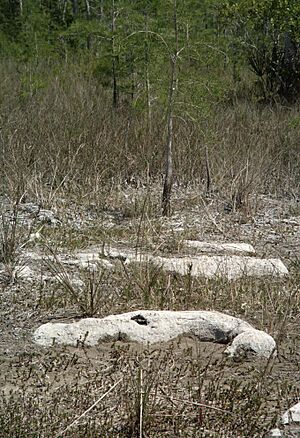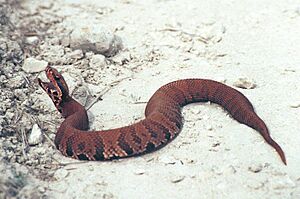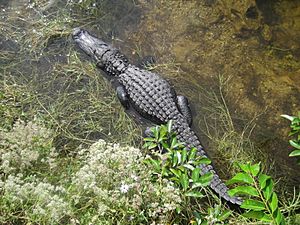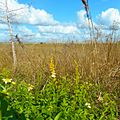Big Cypress National Preserve facts for kids
Quick facts for kids Big Cypress National Preserve |
|
|---|---|
 |
|
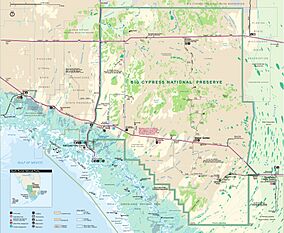
Map of the preserve
|
|
| Location | Collier, Monroe, & Miami-Dade counties, Florida, United States |
| Nearest city | Everglades City, Florida |
| Area | 720,566 acres (2,916.03 km2) |
| Established | October 11, 1974 |
| Visitors | 2,903,159 (in 2022) |
| Governing body | National Park Service |
| Website | Big Cypress National Preserve |
| Lua error in Module:Location_map at line 420: attempt to index field 'wikibase' (a nil value). | |
Big Cypress National Preserve is a huge protected area in South Florida, United States. It's about 45 miles (72 kilometers) west of Miami. This special place covers about 720,000 acres (2,900 square kilometers).
Big Cypress became one of the very first national preserves in the United States National Park System on October 11, 1974. It shares its southern border with Everglades National Park. Water from Big Cypress flows into the famous Ten Thousand Islands area of the Everglades.
Contents
History of Big Cypress
Early People and Settlers
People have lived in the Big Cypress area for over two thousand years. Archaeology at Platt Island shows this. The Calusa people lived here when Europeans first arrived. Later, the Seminole people made this land their home. Today, their descendants include the Miccosukee Tribe of Indians of Florida and the Seminole Tribe of Florida.
In the past, early European-American settlers hunted birds like herons and egrets. Their feathers were popular for hats in the 1800s and 1900s. People also hunted alligators and crocodiles so much that they almost disappeared.
The timber industry also came to the area. They built railroads and cut down most of the old, tall cypress trees. Some parts of Big Cypress were even used for farming winter vegetables.
Oil and Airport Plans
In 1943, oil was discovered in the northwest part of what is now Big Cypress. This was Florida's first successful oil well. When Everglades National Park was created in 1947, Big Cypress was supposed to be part of it. But because the land was privately owned, it was not included at that time.
In the 1960s, there were plans to build a huge new airport called the Miami Jetport here. Construction started in 1968. However, Native Americans, hunters, and people who wanted to protect nature worked together. They stopped the airport construction in 1970. Only one runway was finished, which is now the Dade-Collier Training and Transition Airport.
Becoming a National Preserve
After stopping the airport, these groups campaigned to protect Big Cypress. In 1974, it officially became a National Preserve. This was different from a National Park in some ways. For example, the Miccosukee, Seminole, and other traditional people were given special rights. They can continue to live on and use the land in their traditional ways. They also have the first chance to start businesses related to the preserve, like guided tours.
Hunters can use special off-road vehicles here. People who owned homes or businesses before the preserve was created can keep them. Even though oil exploration was allowed when the preserve was formed, the government is now working to buy out the remaining oil leases. This will help protect the environment even more.
Climate
Big Cypress has a warm, wet climate, much like a tropical monsoon. Days are often very hot, especially in summer. The average high temperature in August is about 93.6°F (34.2°C). In winter, January's average high is around 78.0°F (25.6°C). Nights in winter can cool down to the 50s°F (low 10s°C). It gets above 90°F (32°C) about 154 days a year. It rarely drops below 70°F (21°C).
Plants and Animals
Big Cypress is full of different kinds of plants and animals. It has a wet cypress forest. While many giant cypress trees were cut down long ago, about one-third of the swamp has smaller "dwarf pond cypress" trees.
You can find many amazing creatures here, including:
- Mangrove trees
- Beautiful orchids
- Alligators and crocodiles
- Snakes like the cottonmouth and eastern diamondback rattlesnake
- Many types of birds
- River otters
- Deer
- Bobcats
- Coyotes
- Black bears
- The rare Florida panther
The preserve is also home to animals that are in danger of disappearing. These include the eastern indigo snake and the Florida sandhill crane.
Visiting Big Cypress
Big Cypress has twelve campgrounds where visitors can park their vehicles. You can also bring off-road vehicles to special areas. The southern end of the Florida National Scenic Trail is in Big Cypress. This trail offers great hiking, especially in the cooler winter months.
Hiking is fun in Big Cypress all year. The cypress areas are often easier to walk through than the thick sawgrass prairies of the central Everglades. Some of the best places for wading and walking are in the cypress strands and prairies. These are found between Loop Road and the Tamiami Trail.
You can see lots of wildlife here. Alligators are common and can grow up to 12 feet long. The Florida panther, an endangered animal, also lives here. Both alligators and panthers are usually shy. But it's important to be aware of your surroundings when exploring the cypress country.
Before you go, visit one of the preserve's visitor centers. They have information on current conditions and local trails. You can watch an educational video about the area. Park rangers often lead swamp walks in the dry winter months. They also offer canoe trips and talks on the boardwalks.
Hunting is a long-standing activity in this area and is allowed in the preserve. Hunters helped protect this wild part of Florida. Hunting seasons are available for archery, muzzle loading, and general gun. Common animals hunted include white-tailed deer, turkey, and hogs. However, alligator hunting is not allowed. The National Park Service and the Florida Fish and Wildlife Conservation Commission work together to manage hunting in the preserve.
Gallery


